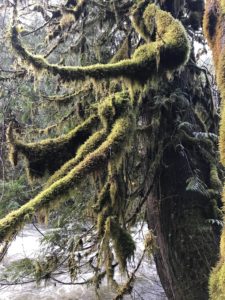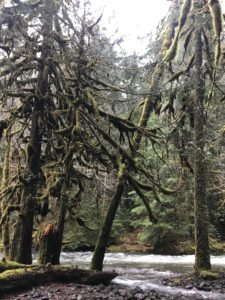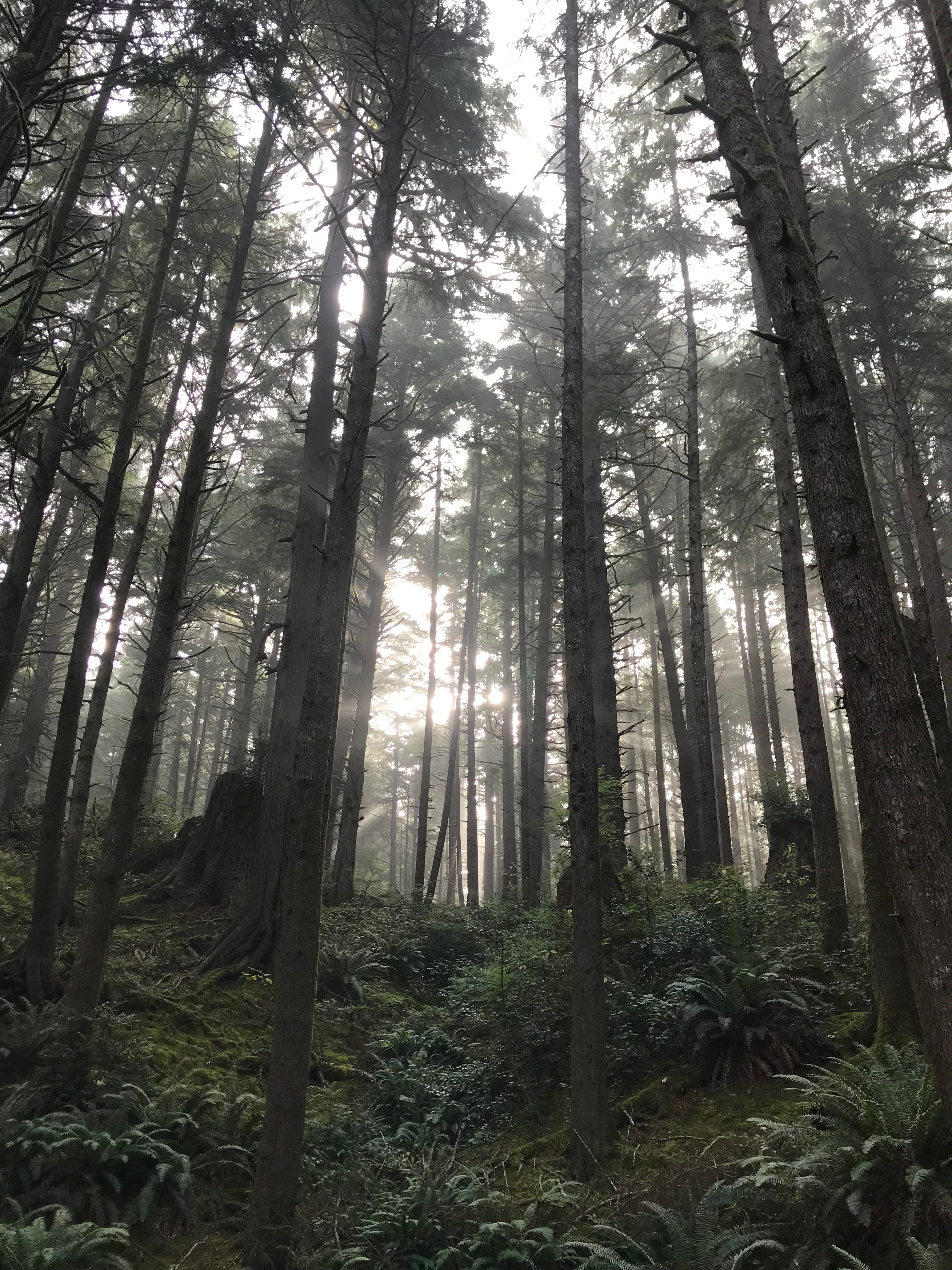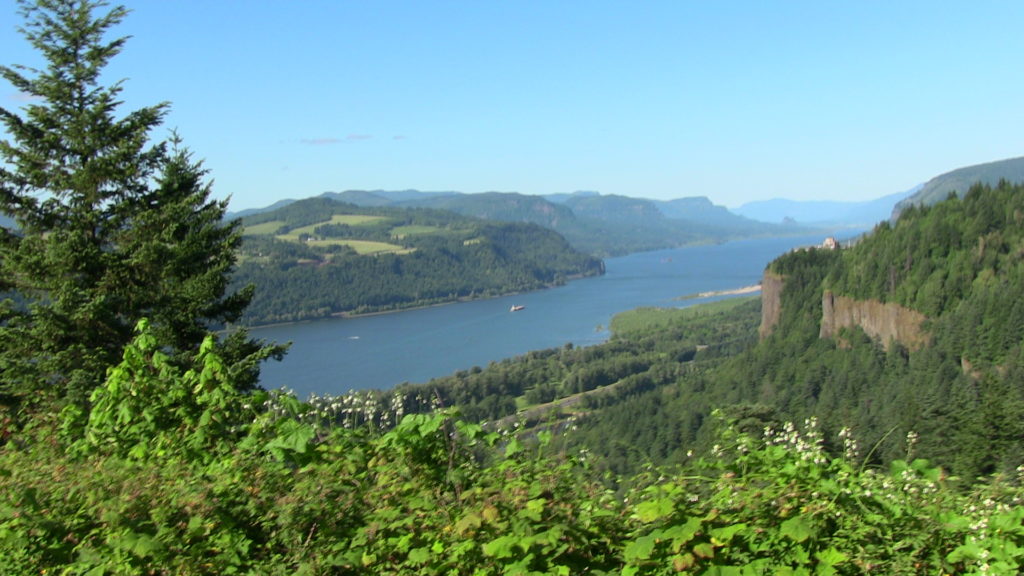The Coastal Conifers Forests of the Pacific Northwest
The purpose of this article is to call attention to the uniqueness of Oregon’s and the Pacific Northwest’s temperate coastal rainforests that many of us take for granted because we live here.
As you will read below, our forests are some of the last like them on the planet; they are the largest of their kind still left. Such forests existed elsewhere on earth, but have long since destroyed them, and little or nothing remains of these temperate coastal rainforests, except in the Pacific Northwest.
Please enjoy and share the information presented below to help raise the awareness of the forest gem we have in our own backyard.
Oregon Conifer Tree Facts
- Oregon has 26 million acres of commercial forests. They would stretch as a green belt sixteen miles wide across the U.S. from the Pacific Ocean eastward to the Atlantic (as of 1989, from Trees to Know in Oregon, by Charles Ross, Oregon State University, Corvallis, OR; 1989)
- Oregon’s forests contain enough lumber to rebuild every dwelling in the U.S. (ibid.)
- Prior to 1990 when the spotted owl ruling shut down most of Oregon’s state and federal forests to commercial timber operations, Oregon led all 50 states in production of timber products. The forest industry provided half of all Oregon’s industrial jobs. Timber was king leading agriculture, transportation, recreation and all other industries (ibid.).
- Douglas fir makes up sixty percent of Oregon’s annual wood crop (ibid.).
- The Douglas fir tree, Oregon’s state tree, is the worlds second largest tree in size after California’s giant redwoods and sequoias (ibid.).
- Of the total timber in the U.S., half is in the three Pacific Coast states combined, and half of this (or one quarter of the timber in the U.S.) is Douglas fir. Douglas fir is not only the leading commercial tree of the Pacific Coast, but of the world (Elliot, p. 524).
- While the Pacific Coast has a small number of species as compared with the species native to the eastern U.S., it is the home of the most dense and important coniferous forests of the world. The hardwoods in the Pacific Coast account for only about one percent of the total available timber in the Northwest, and is chiefly comprised of red alder, Oregon ash, bigleaf maple and Oregon white oak (Elliot, p. 525).
- Many species of trees are native to the Northwest which no longer grow here, since they lie buried under the lava flows of eastern Oregon and Washington. The fossilized remains of extinct trees that have been found include magnolias, palms, ginkgoes and sequoias (Elliot, p. 526).
- More than 600 species of conifers exist on planet earth. Half live on the Pacific Rim and 50 percent of these live in the U.S. (Kauffmann, pp. 10, 14).
- The hot-spot for conifer diversity in the western U.S. is in the Klamath Basin Mountains of Oregon and California where there are 38 species of conifers in 13 genera. Conifers in California alone represent the oldest, tallest and largest living things on the planet (Kauffmann, p. 16).
Distribution of Trees on Planet Earth
Ninety percent of all tree species on earth live in tropical forests (Tudge, p. 27). The further you travel north or south from the tropics at the equator, the fewer the diversity of the species of trees you’ll find. The endless forests of Canada, for example, are dominated by only nine native species of trees including a few conifers and the quaking aspen. In the whole U.S. there are only about 620 native species of trees. India, which is much smaller than the U.S. has around 4,500 species of trees, and in one region of Peru where studies have been conducted within a 15 hectare area 825 tree species have been identified. Tropical America (both North and South) have tens of thousands of species of trees (Tudge, p. 279).
Conifers Distribution Outside and Inside North America
There are no native conifer (a word meaning “cone bearing”) trees (e.g. pines, firs, spruces, junipers, cypresses or cedars) in all the vast forests of Central Africa or Amazonia in South America. This is because most conifers (except firs) thrive in conditions that flowering plants find especially difficult such as soil low in fertility and soil that is poorly drained. They do, however, grow in some highland tropical rainforests on the hillsides of Southeast Asia where growing conditions are less easy. They especially thrive in cooler climates including extreme northern regions such as Canada, Alaska and Siberia. Conifers also thrive in arid regions beset with wildfires, since the extreme temperatures of fire and hot sun are required to melt the resins that keep the seed-bearing cones tightly sealed resulting in their opening thus allowing the seeds to escape and fall to the ground (Tudge, pp. 96–97, 99, 115, 310–312).
Appreciating Our North American Temperate Coastal Rainforests
North America’s coastal temperate rainforests appear as a delicate green fringe adorning the western rim of the continent that is only 50 miles wide and extending in an unbroken line from Alaska’s Kodiak Island through British Columbia, Washington, Oregon and California’s Mendinco County—a distance of more than 2,000 miles (Vaillant, pp. 8–9). 
The mild temperatures within this long, damp corridor between the Pacific Slope and the sea have created what is essentially a vast terrarium. It is an environment perfectly designed to support life on a grand scale, including the biggest freestanding creatures on earth. All of the dominant west coast species—redwood, sequoia, sugar pine, western hemlock, Douglas fir, noble fir, black cottonwood, red cedar and Sitka spruce—are giants of their kind, It is due in large part to these immense trees that the Pacific Northwest support more living tissue, by weight, than any other ecosystem including the equatorial jungle (ibid.).
The principal difference between tropical and temperate rainforests have to do with temperature and location. Whereas tropical rainforests or jungles are found along the Equator, in the hot centers of their home continents, temperate rainforests flourish on the chilly, fog-bound margins, closer to the planet’s poles. These forests prefer a stable climate that is neither too hot nor too cold, and their ideal setting is a west-facing coastline backed by mountains to trap and channel large quantities of snowmelt and rain. These conditions are found in both hemispheres, but only between 40˚ and 60˚ latitude. Conifers in a temperate rainforest will grow continuously as long as the temperature stays above 38˚ Fahrenheit, which is one reason they are able to achieve tremendous sizes (ibid.).
 The coastal rainforests of the Pacific Northwest are, in a sense, endangered, and, therefore, should be treasured and preserved. This is because once upon a time, the lush coastal forests of Japan were a trans-Pacific mirror of the Pacific Northwest’s own forests with mighty conifers growing there and attaining huge sizes due to a similar climate. Today, with the exception of a few lone giants still standing in parks or on temple grounds in Japan, those forests are gone. The Highlands of Scotland, a place long associated with barren scape of moorland and heather, hosted a temperate rainforest as well. So did Ireland, Iceland, and the eastern shores of the Black Sea. While the North Sea coast of Norway retains vestigial traces of it original rainforests, Chile, Tasmania and New Zealand’s South Island are the only places left with forests whose flora, feel and character remotely resemble those of the Pacific Northwest, which host the largest such forests in the world (ibid, p. 9).
The coastal rainforests of the Pacific Northwest are, in a sense, endangered, and, therefore, should be treasured and preserved. This is because once upon a time, the lush coastal forests of Japan were a trans-Pacific mirror of the Pacific Northwest’s own forests with mighty conifers growing there and attaining huge sizes due to a similar climate. Today, with the exception of a few lone giants still standing in parks or on temple grounds in Japan, those forests are gone. The Highlands of Scotland, a place long associated with barren scape of moorland and heather, hosted a temperate rainforest as well. So did Ireland, Iceland, and the eastern shores of the Black Sea. While the North Sea coast of Norway retains vestigial traces of it original rainforests, Chile, Tasmania and New Zealand’s South Island are the only places left with forests whose flora, feel and character remotely resemble those of the Pacific Northwest, which host the largest such forests in the world (ibid, p. 9).
Like giants moving in a slow progression that’s visually imperceptible, the trees of the Pacific Northwest have been marching up and down the coast for eons fleeing southward with each ice age and reclaiming lost territory as the glaciers receded. The current rebound is still underway, such that the Sitka spruce, for example, is advancing northward further into Alaska at a rate of about one kilometer every century (ibid, p. 9).
The Pacific Northwest coastal temperate rainforest is teeming with life. It has been estimated that a square meter of forest soil can contain as many as two million creatures representing one thousand species. Andy Moldenke, an entomologist at Oregon State University, calculated what might be found within the area of an average-sized shoe. He determined that a single footstep in one of Oregon’s coastal forests is taken on the backs of sixteen thousand invertebrates (ibid, p. 11).
Of all the West Coast conifers, the Sitka spruce seems the most naturally suited to the maritime environment. Its long, narrow geographic distribution mirrors that of the Pacific rainforest, and the species shows a preference for planting itself in the teeth of the gale. Sitka spruce is the world’s largest and longest lived species of spruce; it can live for more than 800 years and grow to heights exceeding 300 feet, which is tall even for a redwood. Despite the colossal end result, their beginnings are almost unimaginable humble. A single Sitka spruce seed weighs only 1/13,000 of an ounce, and yet it contains all the information needed to produce a tree that can weigh 300 tons—about as much as three blue whales. While the species is common up and down the coast, these mega-spruces grow only in a handful of places (ibid p. 16).
Bibliography of Sources
Conifers of the Pacific Slope, by Michael Edward Kauffmann, Backcountry Press, Kneeland, CA; 2013
Forest Trees of the Pacific Coast, by Willard A. Elliot, G.P. Putnam’s Sons, New York, N.Y.; 1938
The Golden Spruce, by John Vaillant, N.W. Norton & Co, New York, NY; 2005
The Secret Life Trees—How They Live and Why It Matter, by Colin Tudge, Penguin Books, New York, N.Y.; 2017
Trees to Know in Oregon, by Charles Ross, Oregon State University, Corvallis, OR; 1989
Stay tuned. More interesting information will be added to this article as I discover it…


